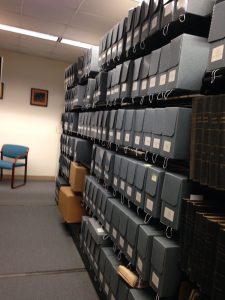[The following text is an edited version of a presentation “A Treasure Trove of Alcohol Science: The Digital Alcohol Studies Archives at Rutgers” hosted by the Scholarly and Professional Activity Committee of Rutgers University Libraries on December 1, 2021. See more.]
Thank you to Judit and Nick for giving me the opportunity to reflect on my experiences with the alcohol archives. It has been over five years since I worked really closely with this material, but will give a brief overview of its impact from my perspective, and then hand it off to Nick to elaborate further on the research and usefulness of this archive from his point of view.
I’ve been teaching the Digital Libraries course at SC&I this semester, and I’ve invited students from my class to join to see a full digitization project in progress. We’ve been speaking a lot about the particular issues involved in digitization, preservation, organization, and metadata in a theoretical sense, and we’ve been going through some weekly exercises to give some tangible, hands-on experience as well, but there is really no substitute for seeing how a project like this plays out in real time and experiencing various unanticipated challenges that arise over the course of its development. The students are currently working on their term projects, which are either a prototype of a digital library, a proposal to develop a digital library, or an evaluation of a set of digital libraries. In any of these endeavors, it is useful to consider a digital library through its potential significance, originality/value, methods involved in its creation, and its organization or design. I’ll give some very brief thoughts through this perspective that hopefully complement the rest of the presentation.
Significance
I think the novelty of this collection lies in the ability to see the emergence and shaping of an academic field in many ways from its inception. The CAS documentation, both published and unpublished, provides an insight into the continuity and development of an applied multidisciplinary field through both the personal lives and professional works of its founders. Those impacted by or involved in the addiction field, whether as a researcher, a historian, or a practitioner, ought to know its history and trajectory. A prime example of this is the deliberate decisions made to define the problem of addiction and substance misuse as a multifaceted one (i.e., not merely a moral or medical issue), which was addressed by the diversity of the original research team, including researchers from both the natural and social sciences, a documentation specialist, those working in the recovery field, and all led by the interdisciplinary visionary, E. M. Jellinek.
 Originality & value
Originality & value
We spent some time in our course discussing how to define value in terms of a collection or services provided by a library. One potential criterion is the rarity of a collection—i.e., the ability to offer something that cannot be found elsewhere. Much of the archival CAS material is either the only copy available or includes documentation in which Rutgers holds the copyright, and thus has the authority to make decisions about its dissemination. Another form of value can be found in convenience and in bringing in a collection of material that was previously not gathered in one place. These items may have existed for those who were diligent enough to hunt them down, but offering public access to them (even if only their records) allows a researcher or interested party to review these documents in the context of the field’s history.
Method
We are very fortunate to have Isaiah’s expertise on the technical aspects of the project, and Geoff’s expertise on the metadata. All I will say in regard to method is to stress the importance of keeping multiple backups of any projects being worked on. When the CAS library shut down somewhat abruptly in 2016, the digitization project as we knew it was essentially ended, but because of Judit’s diligence in preserving the raw files and metadata, this project did not have to start from scratch and the work we did over five years ago was not all done in vain.
Organization/design
Finally, just a brief mention about the design of the digital library: Both the Omeka and WordPress sites are intuitive, easy to navigate, clearly organized, and make good use of the space provided. It’s sometimes natural to overthink or overproduce a digital library’s design, but these are clearly made with the user in mind and make easy and convenient access to the collection its priority.
Comments from MI students
“The platform was extremely pleasing on the eyes. I was kind of shocked on a number of levels with the presentation. For example, hearing how the different librarians were inspired to participate in this project. Or why the librarians thought this content was necessary to preserve were motivating factors to show the importance of digital preservation.”
“The convenience of being able to view all the material here as well as how simple the content is to view. I hope in my proposal for my Digital Library class to stress many of those attributes that were laid out in this meeting.”
“My biggest takeaway from the presentation was the point that you have to find something in the library field that you are passionate about. Listening to the staff talk about this project showed me the importance of pursuing that passion while stressing the need for digital preserving this material.”
